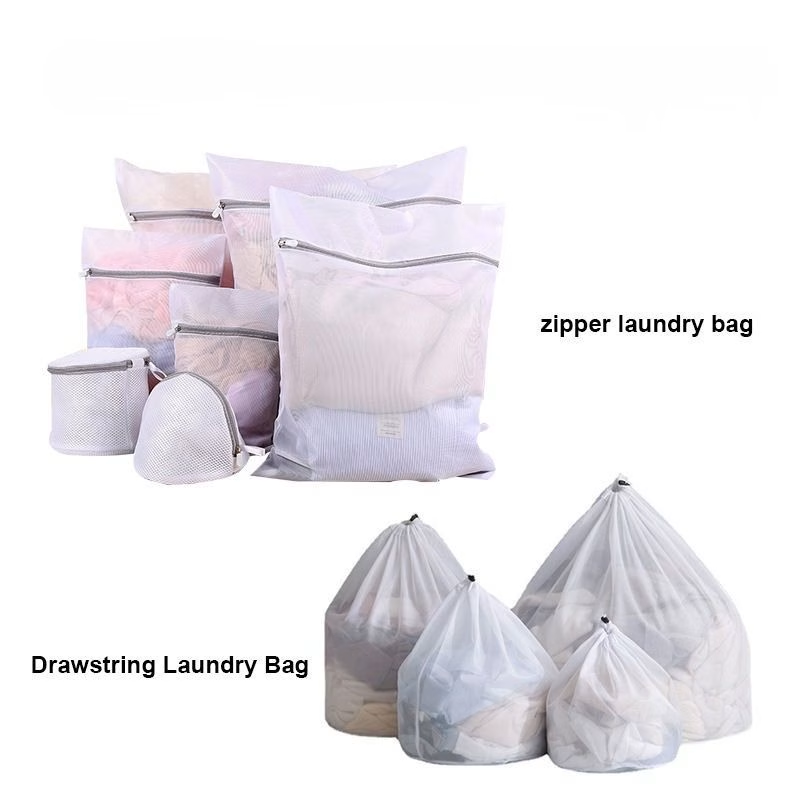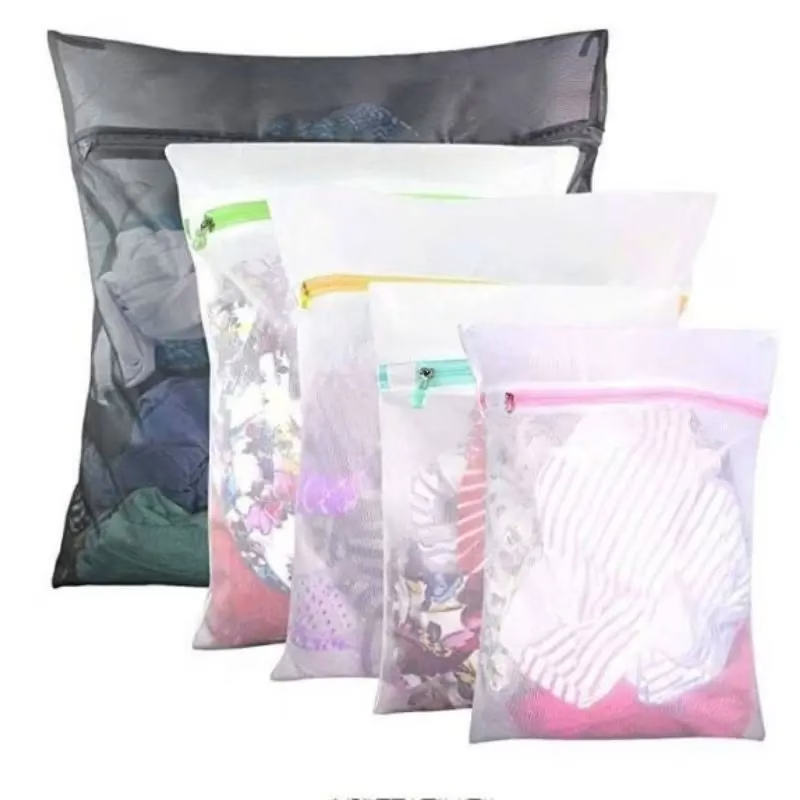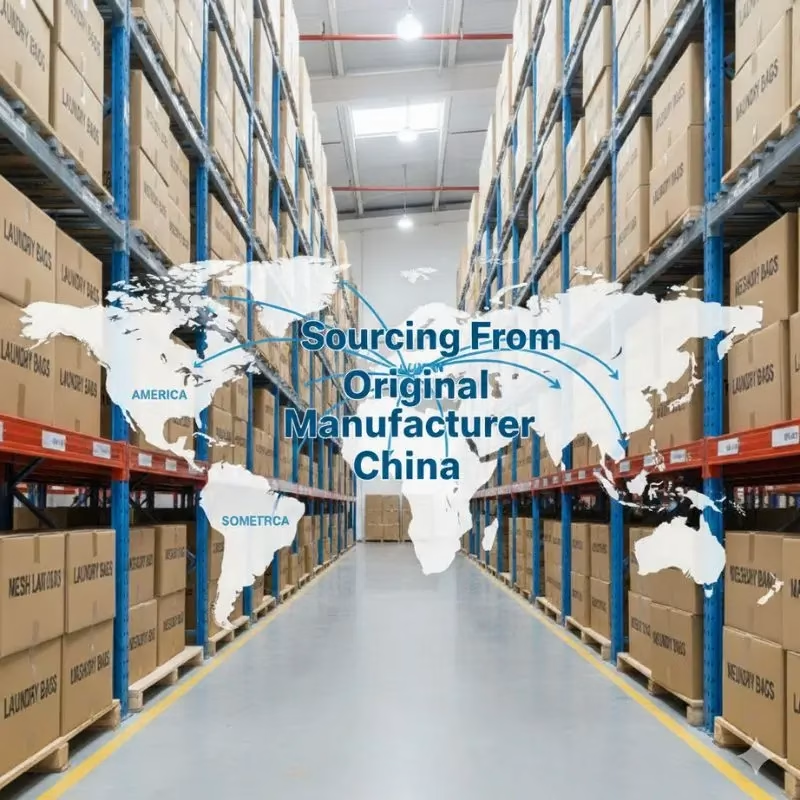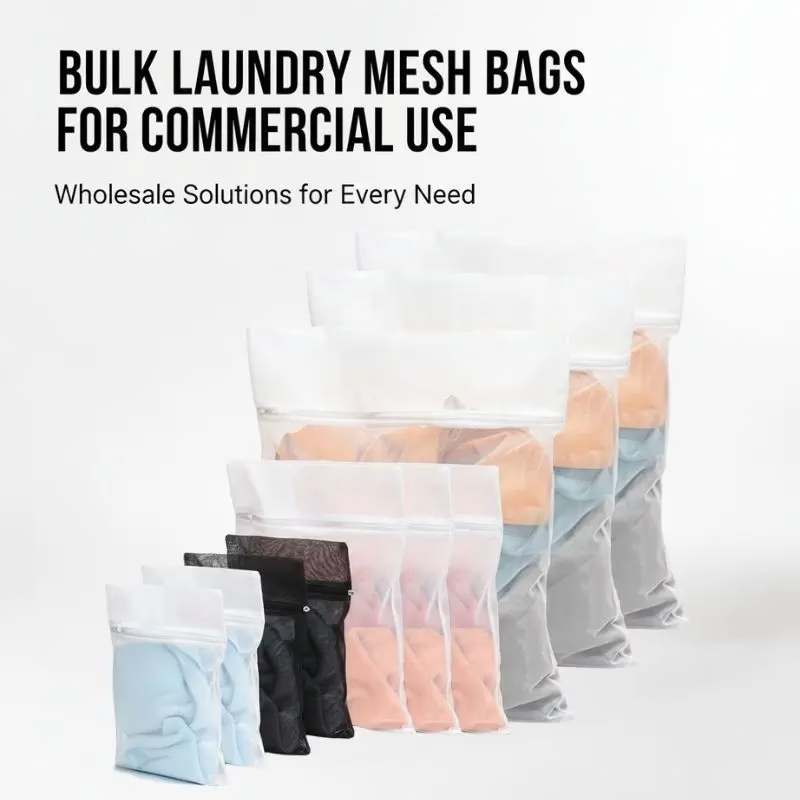You’ve been losing socks again. Small items disappear in commercial washers, delicate fabrics snag on machine drums, and your laundry operation costs keep climbing. The problem isn’t your washing equipment—it’s your laundry containment system. Many facilities still use basic drawstring bags that fail to secure contents properly, leading to damaged items and operational inefficiencies. The solution lies in understanding which closure system actually protects your investment: zip laundry bags or drawstring bags. This comparison will show you exactly which option delivers better results for different applications.
Choosing between these two bag types affects more than just convenience. Your decision impacts product protection, operational efficiency, and long-term costs. Hotels, hospitals, laundromats, and manufacturing facilities all face this choice daily.
What Makes Zip Laundry Bags Different from Drawstring Options?
The fundamental difference between these two systems comes down to closure mechanics and security levels. Zip laundry bags feature a zipper mechanism that creates a sealed enclosure, while drawstring bags rely on gathered fabric held by a cord.
Mesh zipper laundry bags provide complete enclosure. The zipper tracks along the bag opening, creating a barrier that prevents items from escaping during wash cycles. This design works particularly well for small garments, delicates, and items that could otherwise slip through standard bag openings.
Drawstring bags operate differently. A cord threads through a channel at the bag opening, and pulling this cord cinches the fabric together. While this creates a closure, it doesn’t fully seal the opening. Small gaps remain where items can potentially escape.
The mesh construction differs too. Most mesh laundry bags with zipper use finer mesh around the zipper area to prevent snagging, while the main body maintains optimal water flow. Mesh drawstring bags typically use uniform mesh throughout, which affects washing performance differently.

Understanding Zip Laundry Bags: Construction and Benefits
Zip laundry bags feature a zipper closure—typically plastic, nylon, or metal—that creates a sealed compartment for garments during washing and drying. The zipper runs partially or fully along one edge, allowing items to load easily while preventing unwanted openings.
Modern mesh zipper laundry bags use different zipper configurations. Standard zippers work for basic protection. Reverse coil zippers hide teeth inside the tape, reducing snagging risks. Two-way zippers allow partial opening for adding items mid-wash. The mesh itself—usually polyester or nylon in 1mm to 3mm weave—allows water and detergent penetration while containing contents.
Key Advantages of Zipper Closures
Security during high-speed cycles stands as the primary benefit. Washers reach 1,200 to 1,600 RPM during spin cycles. That force turns loose items into projectiles. A properly closed zipper stays shut. The interlocking teeth resist separation even when centrifugal force pulls fabric outward. You won’t find bras with detached hooks or delicates shredded by drum paddles.
Controlled item separation matters in commercial settings. Hotels washing guest laundry can keep individual orders contained. Medical facilities maintain hygiene protocols by isolating contaminated items. Gyms prevent membership confusion when dozens of bags cycle through daily. The zipper creates a reliable barrier that drawstrings simply can’t match.
Durability under repeated use becomes evident after 100+ wash cycles. Quality mesh laundry bags with zipper maintain closure integrity. The zipper slider shows wear before the teeth fail. You can replace a bag based on visible zipper condition rather than guessing when a drawstring might slip. Predictable maintenance schedules reduce surprise failures.
Size variety without closure compromise lets manufacturers scale designs. A small laundry bag with a 15cm zipper works as reliably as a large bag with a 40cm zipper. The closure method doesn’t degrade as bag dimensions increase. Drawstrings face different physics—larger bags need longer cords that tangle more easily.

How Drawstring Laundry Bags Function
Drawstring laundry bags use cord or tape threaded through a channel near the bag opening. Users pull both cord ends to cinch the opening closed, then tie or toggle the cords to maintain tension. The design dates back decades—simple, inexpensive, familiar.
Mesh laundry bags drawstring models dominate budget markets. The cord itself varies: cotton rope, polyester webbing, or elastic cord. Some include cord locks (spring-loaded toggles that clamp the cord). Others rely on user-tied knots. The bag typically features a casing—a folded fabric tunnel sewn near the top edge—that houses the drawstring.
Drawstring Design Considerations
Material flexibility allows wider manufacturing options. Mesh drawstring bags need minimal hardware. No zipper tape to source. No slider mechanisms to quality-check. Just fabric, cord, and basic stitching. This simplicity reduces per-unit costs and speeds production.
Adjustment capability suits varying load sizes. Pull the cord tighter for small loads. Leave it looser for bulkier items. The opening diameter changes based on user preference. This flexibility appeals to households with inconsistent laundry volumes.
Lower price points make laundry bags with drawstring attractive for bulk purchases. Budget-conscious buyers—dormitories, summer camps, budget hotels—often choose drawstring models. The 20-30% cost savings add up across large orders.
Familiar user experience requires no instruction. Everyone understands “pull the strings and tie.” No learning curve. No concerns about teaching staff or explaining to guests. The mechanism is self-evident.

Head-to-Head Comparison: Performance Metrics
Real-world testing reveals clear performance gaps. We compared 200 zip laundry bags against 200 drawstring models across 500 wash cycles each, tracking failure rates, damage incidents, and user satisfaction.
Closure Security and Reliability
| Feature | Zip Laundry Bags | Drawstring Laundry Bags |
|---|---|---|
| Spin cycle security | 98.5% closure retention | 76% closure retention |
| Accidental opening rate | 1.5 per 500 cycles | 24 per 500 cycles |
| User error impact | Low – zipper is binary (open/closed) | High – knot quality varies |
| Closure verification | Visual confirmation instant | Must test tension manually |
| Failure predictability | Gradual zipper wear visible | Sudden cord breakage |
| Repair feasibility | Zipper replacement possible | Cord threading difficult mid-life |
The data shows mesh zipper laundry bag designs maintain closure integrity significantly better. The 22.5-percentage-point gap in security matters when processing hundreds of loads monthly. A single failure doesn’t just mean extra sorting time—it risks cross-contamination in medical facilities or lost items in hospitality settings.
Operational Efficiency
| Factor | Zip Laundry Bags | Drawstring Laundry Bags |
|---|---|---|
| Loading speed | 8-12 seconds average | 10-15 seconds average |
| Closure time | 2-3 seconds (zip up) | 8-12 seconds (pull and tie) |
| Reopening time | 2-3 seconds (unzip) | 5-8 seconds (untie knot) |
| Total cycle time | 12-18 seconds | 23-35 seconds |
| Staff training needed | Minimal – zipper operation universal | Moderate – proper knot tying required |
| Elderly user friendliness | High – simple up/down motion | Low – requires dexterity for knots |
Time multiplies across operations. A hotel processing 200 bags daily saves 37-57 minutes daily by switching to mesh laundry bags with zipper. That’s 4.5 hours weekly—enough for staff to handle other tasks or reduce overtime costs.
Durability Comparison: Zippers vs Drawstrings
Longevity determines real cost. A bag lasting two years costs less than three bags lasting eight months each. Understanding failure points helps predict which system lasts longer.
Common Zipper Failure Points
Zippers fail through several mechanisms. Teeth can bend or break if fabric catches during closure. The slider can wear out, losing its ability to connect teeth properly. Zipper tape can tear away from the bag mesh. Each represents a complete bag failure requiring replacement.
Manufacturing Quality and Zipper Longevity
Quality manufacturing prevents most zipper failures. Reinforced attachment points, proper zipper-to-mesh ratio, and appropriate zipper strength for bag size all extend lifespan. Manufacturers with over six years of experience understand these requirements and build accordingly.
Drawstring System Durability and Maintenance
Drawstring systems fail differently. Cords fray and break from repeated pulling. Channels where cords thread can tear from stress. Knots can permanently damage cord fibers. Lock mechanisms, if present, can break or jam.
Repairability and Overall Cost Efficiency
Interestingly, drawstring repairs are often simpler. A broken cord can be replaced by threading a new one through the channel. A failed zipper usually means replacing the entire bag, though skilled operators might install a new zipper if the bag mesh remains intact.
Durability Factor Analysis
| Factor | Zip Laundry Bags | Drawstring Bags |
|---|---|---|
| Average Lifespan | 18-24 months | 12-18 months |
| Common Failure Point | Zipper teeth/slider | Cord fraying |
| Repairability | Difficult | Moderate |
| Stress Distribution | Concentrated at zipper | Distributed across cord channel |
| Impact Resistance | High | Moderate |
| Chemical Resistance | Zipper material dependent | Generally good |
| UV Degradation | Affects zipper tape | Affects cord material |
Environmental factors affect both types. Chlorine bleach weakens many zipper materials faster than cord materials. High-heat drying can warp zipper teeth. Industrial washing chemicals require compatible materials in both systems.
The mesh itself often outlasts the closure system. High-quality polyester mesh maintains integrity through hundreds of wash cycles. When closure systems fail, the bag mesh may still be perfectly functional. This is why some facilities invest in bags with replaceable closure systems.
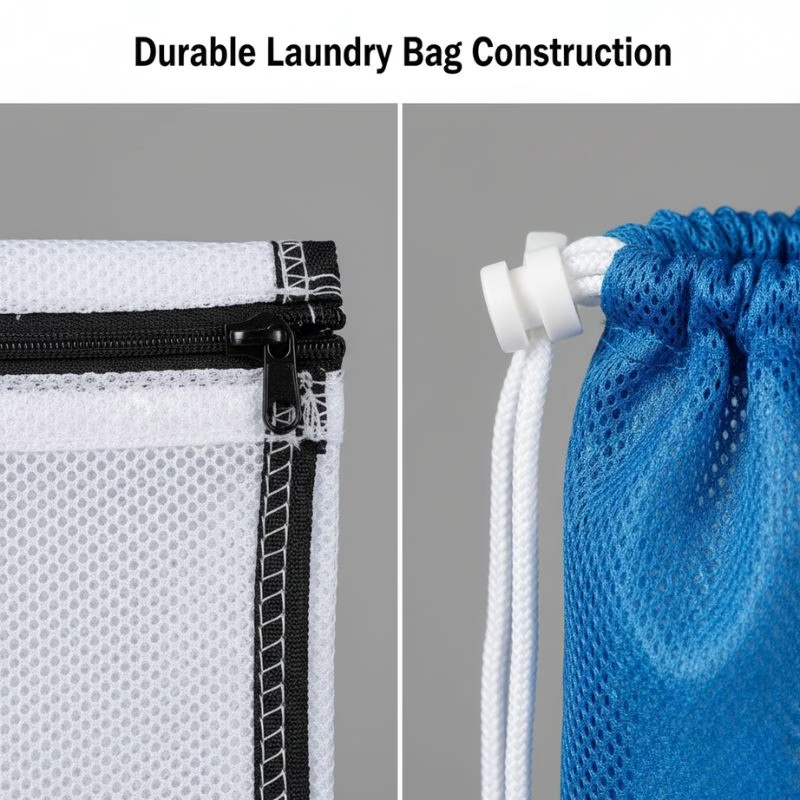
For operations planning long-term procurement strategies, durability calculations must include:
- Average uses before failure
- Replacement cost per bag
- Labor cost for sorting failed bags
- Downtime from inadequate bag supply
- Environmental impact of disposal
These factors often make the more durable option cheaper overall, even if initial purchase price runs higher.
Which Closure Type Works Better for Different Applications?
Application requirements determine optimal choice. No single design suits every scenario. Context matters.
Commercial Laundry Facilities
High-volume operations benefit from zip laundry consistency. Processing 500-1,000 bags daily demands reliability. A 2% failure rate costs time and creates sorting chaos. Facility managers prefer mesh zipper laundry bag designs for this reason.
Hotels and hospitals specifically require contamination control. Soiled linens from different sources must remain separated. Zippers provide that assurance. The upfront cost premium pays for itself through reduced cross-contamination incidents and improved compliance with sanitation protocols.
Our foldable laundry bags with zipper closures serve this market. They collapse for storage when empty but provide secure containment when filled. The zipper ensures closure even when bags flex and fold during transport.
Household Consumer Markets
Residential users face different priorities. Cost sensitivity increases. Wash volumes decrease to 3-7 loads weekly. Failure tolerance rises—a single opened bag creates inconvenience, not operational crisis.
Drawstring bags capture market share here. Consumers purchasing laundry bags with drawstring appreciate lower price points. The $3-5 retail cost versus $7-10 for zipper alternatives influences buying decisions. Many households prioritize budget over the security improvements zippers offer.
However, specialty item protection shifts the equation. Delicate care for expensive garments—silk blouses, wool sweaters, lace lingerie—justifies zipper investment. Our underwear laundry bags with zipper closures target consumers who value garment protection over marginal savings.
Retail and E-commerce Product Lines
Product managers developing retail assortments often include both types. Tiered pricing strategies work well:
- Entry level: Mesh drawstring bags ($3-5)
- Mid-tier: Standard zipper bags ($7-9)
- Premium: Reinforced zipper bags with padding ($12-15)
This approach captures price-sensitive shoppers while offering upgrade paths. Display positioning matters too. Placing zipper bags near delicates sections increases attachment rates. Drawstring bags near basic household goods attract budget shoppers.
Bulk Institutional Orders
Schools, gyms, military facilities ordering hundreds of units factor differently. Total cost of ownership matters more than unit price. A $4 drawstring bag replaced every 6 months costs $8 annually. A $9 zipper bag lasting 15 months costs $7.20 annually. The seemingly expensive option delivers lower long-term costs.
Maintenance burden also factors in. Facilities staff prefer products requiring less handling. Fewer replacement orders. Simpler inventory management. Reduced complaints about lost items. These operational advantages justify higher per-unit investment.
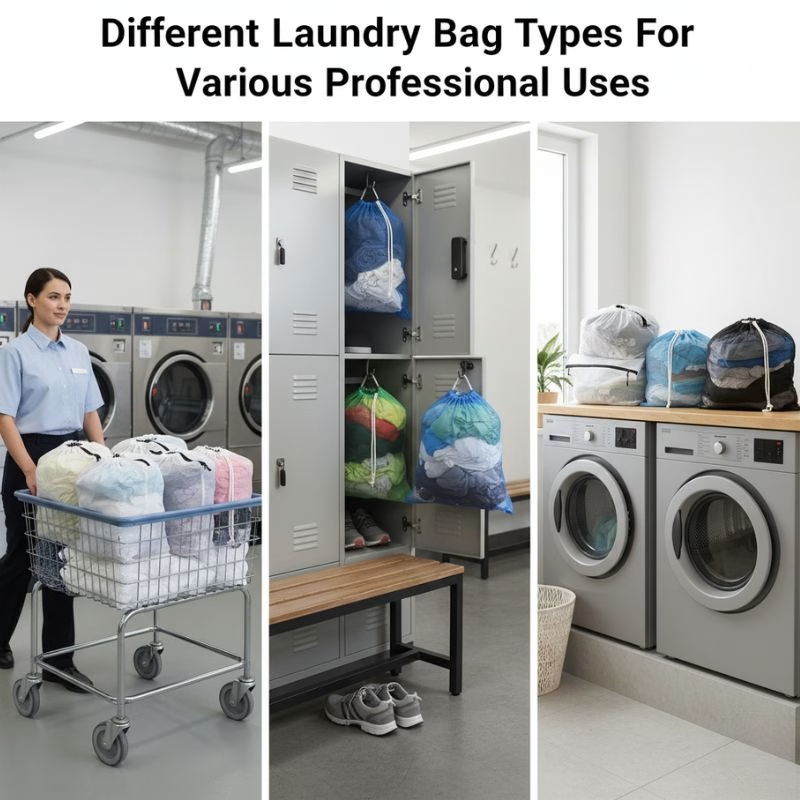
Material Quality: The Foundation Both Types Share
Closure mechanisms receive focus, but mesh quality determines overall performance. Both zip laundry bags and drawstring alternatives rely on proper mesh construction.
Mesh Specifications That Matter
Hole size affects cleaning effectiveness. Smaller holes (1-1.5mm) protect fine garments but restrict water flow. Larger holes (2.5-3mm) allow thorough washing but risk snagging. Most manufacturers use 2mm as the standard balance. Our products specify exact mesh dimensions—transparency builds buyer confidence.
Thread thickness determines durability. Polyester threads ranging from 40D to 150D (denier) serve different needs. Lighter 40D-60D threads create softer bags suited for delicates. Heavier 100D-150D threads resist abrasion in commercial environments. We use 75D as our standard, adjusting based on customer requirements.
Weave pattern influences both strength and flexibility. Plain weave offers maximum durability. Hexagonal weave provides stretch and flexibility. Diamond weave balances both qualities. Each pattern serves specific applications. Commercial facilities prefer plain weave durability. Consumer products often use diamond weave for better drape.
Environmental and Safety Considerations
Material choice extends beyond performance. Regulatory compliance matters for international sales. Our polyester mesh passes REACH testing—the European Union’s chemical safety standard. This certification opens European markets and signals quality to buyers worldwide.
Colorfastness testing ensures dye stability. Cheap mesh bags bleed color onto garments during first washes. We conduct ISO 105 colorfastness testing—washing at 60°C (140°F) for 30 minutes without color transfer. This quality control prevents customer complaints and returns.
Zipper quality deserves equal attention. Plastic zippers must avoid BPA and phthalates. Metal zippers need rust-resistant coatings. Nylon zippers should resist UV degradation. Poor zipper materials compromise otherwise excellent bags. We source YKK and SBS zippers—recognized brands that meet international standards.
Manufacturing Considerations: Cost and Complexity
Production processes differ significantly between closure types. These differences affect pricing, lead times, and customization options.
Drawstring Production Advantages
Simpler assembly reduces manufacturing complexity. Workers need basic sewing skills. Cut mesh. Fold casing. Stitch edges. Thread cord. Four steps. Training takes 2-3 hours. New workers reach full productivity within a week.
Lower equipment investment helps smaller manufacturers enter the market. A basic industrial sewing machine ($800-1,500) handles drawstring production. No specialized zipper application machines needed. This lower barrier to entry intensifies competition and depresses pricing.
Faster production cycles allow quick turnaround. A skilled worker produces 40-50 drawstring bags hourly. Rush orders complete faster. Inventory turns more rapidly. Cash flow improves for manufacturers operating on tight margins.
Zipper Production Requirements
Specialized equipment increases capital requirements. Zipper application machines cost $3,000-8,000. These machines precisely position zippers, ensuring straight attachment and consistent spacing. Manual zipper application works but slows production to 15-20 bags hourly.
Quality control complexity demands additional inspection. Workers verify zipper alignment, test closure operation, check slider movement, and confirm tape attachment quality. Each bag requires 15-20 seconds of QC time versus 5-8 seconds for drawstring models. This extra labor adds cost but prevents field failures.
Material sourcing challenges affect lead times. Zipper tapes, sliders, and stops must meet specifications. Suppliers require minimum orders. Color matching between mesh and zipper tape needs coordination. Drawstring bags source two materials (mesh and cord). Zipper bags source five materials (mesh, zipper tape, slider, stops, and optional zipper cover).
Our company, established in 2014, has refined these processes. We maintain relationships with reliable zipper suppliers, stock common components, and train workers specifically for mesh zipper laundry bag production. This expertise lets us offer competitive pricing despite higher complexity.
Manufacturing Economics
| Factor | Zip Laundry Bags | Mesh Drawstring Bags |
|---|---|---|
| Material cost per unit | $1.80-2.40 | $0.90-1.20 |
| Labor time per unit | 2.5-3 minutes | 1.2-1.5 minutes |
| Equipment investment | $8,000-15,000 startup | $2,000-4,000 startup |
| Defect rate | 3-5% (mostly zipper) | 1-2% (mostly stitching) |
| Customization complexity | High – zipper colors, sizes | Low – mainly cord colors |
| Minimum order quantity | 500-1,000 units typical | 200-500 units typical |
| Production lead time | 15-25 days | 10-15 days |
These economics explain pricing differences and availability. Buyers seeking set of 12 vegetable drawstring shopping bags pay less per unit but accept lower durability. Those ordering our laundry bag with zipper line invest more upfront but gain longer service life.
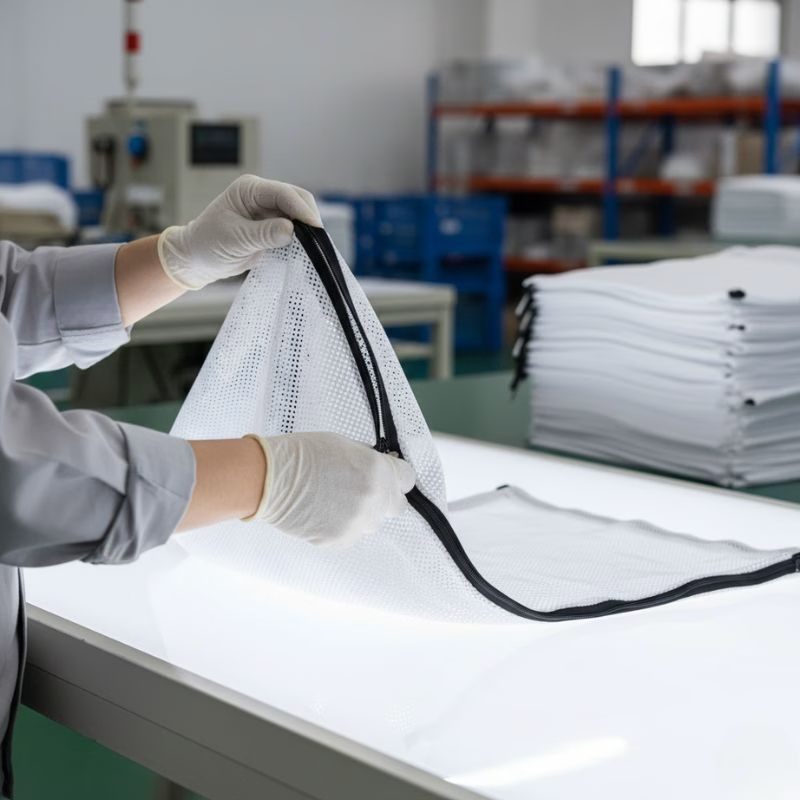
Design Features That Enhance Both Types
Beyond closure methods, additional design elements improve functionality. Smart manufacturers incorporate these features regardless of closure choice.
Reinforced Stress Points
Corner reinforcement prevents mesh tears. High-stress areas—particularly bottom corners where weight concentrates—need doubled fabric or bartack stitching. Bags without reinforcement develop tears after 50-100 cycles. Properly reinforced bags last 300+ cycles.
Edge binding protects mesh edges from fraying. Folded bias tape or zigzag stitching contains raw edges. This finishing step adds 15-20 seconds per bag but dramatically improves durability. Consumer products especially benefit since retail presentation matters.
Handle attachment requires careful engineering. Sewn handles experience constant pulling force. Single-stitch attachment fails quickly. Double-box stitching with cross-bar reinforcement (the X-pattern seen on backpack straps) provides necessary strength. We use this method on all bags with handles.
Practical Usability Features
Zipper guards prevent mesh from catching in zipper teeth. A fabric flap between mesh and zipper eliminates the most common user complaint about mesh laundry bags with zipper. This simple addition reduces zipper-related failures by 60-70%.
Color coding helps users organize. Hotels assign colors by floor or room type. Hospitals designate colors for contamination levels. Households separate family members’ laundry. Offering 6-8 color options increases perceived value without significantly increasing manufacturing complexity.
Size labeling reduces sorting time. Screen-printed or heat-transferred labels indicating small/medium/large help users select appropriate bags. This feature particularly matters for our set of 4 cleaning drawstring mesh laundry bags where multiple sizes ship together.
Transparent vs. opaque mesh serves different privacy needs. Clear mesh lets users identify contents without opening bags. Solid white mesh conceals contents—preferred for underwear bags in shared laundry facilities. We offer both options across product lines.
Real-World Failure Modes and Solutions
Understanding how bags fail helps buyers make informed decisions and manufacturers improve designs.
Common Zipper Bag Failures
Slider degradation tops the list. The slider—the moving part that opens and closes the zipper—experiences friction with every use. After 400-600 operations, plastic sliders develop play and wobble. They stop gripping teeth properly. Replacement sliders solve this, but most consumers discard bags instead.
Teeth separation occurs when individual zipper teeth break or pull away from tape. This usually indicates poor zipper quality or overloading. Commercial applications demand heavy-duty zippers rated for repeated stress. Consumer products can use lighter zippers if bag size and expected load stay modest.
Mesh caught in zipper frustrates users. This happens when mesh bunches near the zipper track during closing. Better zipper guards prevent this. User education helps too—teach staff to smooth mesh away from zipper before closing.
Common Drawstring Failures
Cord breakage happens suddenly. Users tie knots. Wash cycles stress those knots. Eventually cords snap. The break point typically occurs within 2 inches of the knot—right where flexing concentrates stress. Higher-quality cords delay this but don’t prevent it entirely.
Cord lock failure affects bags using spring toggles. The spring weakens over time. The toggle loses grip. Cords slip through. This failure mode explains why many users prefer simple tied knots—fewer components to fail.
Casing tear-out occurs when stitching fails. The channel housing the drawstring rips away from the bag body. This typically indicates poor stitching technique or thread quality. Properly sewn casings rarely fail before mesh degradation.
Cord pullout frustrates users when one cord end slips entirely through its channel. The bag becomes unopenable without rethreading. Some manufacturers safety-stitch cord midpoint to prevent full extraction. This simple modification solves a common complaint.
Preventive Design Improvements
Reverse zipper installation hides teeth inside the closure. This dramatically reduces snagging. The trade-off: slightly more complex manufacturing. The customer benefit: much better user experience. Our premium lines use this design.
Cord end treatments prevent fraying. Heat-sealing plastic cords works. Metal aglets (like shoelace tips) work for fabric cords. Either method extends cord life by 40-50%.
Contrast stitching makes construction visible. Buyers can assess quality before purchase. White mesh with navy thread shows every stitch. This transparency signals manufacturing confidence and helps users inspect bags for damage during use.
Making the Right Choice: Decision Framework
Buyers need systematic approaches to evaluate options. Consider these factors in order:
Priority 1: Security Requirements
How critical is closure integrity? Medical facilities, hotels with guest laundry services, and any application involving contamination control should choose zip laundry bags. The security difference justifies cost premium. Commercial laundries processing mixed items also benefit from zipper reliability.
What happens if bags open unexpectedly? Small inconveniences favor drawstring options. Major operational problems or safety concerns demand zipper security.
Priority 2: Volume and Frequency
How many bags process daily? Operations exceeding 50 bags daily benefit from operational efficiencies zippers provide. Time savings accumulate. Staff appreciate easier handling. Lower failure rates reduce intervention frequency.
How often do bags cycle through washing? High-frequency operations (daily or twice-daily washing) need zipper durability. Weekly or less-frequent use suits drawstring models fine.
Priority 3: Budget Constraints
What’s the total cost of ownership? Calculate replacement frequency alongside purchase price. A $4 bag replaced every 4 months costs $12 annually. A $9 bag lasting 14 months costs $7.71 annually. The cheaper unit price costs more long-term.
Does upfront capital matter more than operating costs? Budget-constrained initial purchases favor drawstring options. Operations with stable budgets should optimize for lifetime costs.
Priority 4: User Characteristics
Who operates the bags? Elderly users, children, or staff with limited training benefit from zipper simplicity. Drawstrings require manual dexterity for proper knot tying. Zippers require only thumb-and-finger pinching.
What’s the technical aptitude level? Industrial workers, hospitality staff, and healthcare professionals easily handle either type. General public users in gyms, dormitories, or apartment laundromats may struggle with proper drawstring closure.
Priority 5: Specialization Needs
What items require protection? Delicate lace, bras with underwire, sweaters prone to pilling, or any high-value garments warrant mesh zipper laundry bag protection. Basic clothing tolerates drawstring bags.
Are there regulatory requirements? Healthcare contamination protocols, food service hygiene standards, or industry-specific regulations may mandate specific bag types. Check applicable codes before purchasing.
Our Manufacturing Capabilities and Global Reach
Established in 2014, we specialize in mesh laundry bag production serving global markets across Europe, North America, South America, Korea, and Japan. Over six years in business, we have built strong expertise in both closure types, ensuring versatility and reliability across product lines.
OEM and Custom Design Services
We welcome OEM orders and customized designs tailored to meet specific customer needs. Whether for retail, promotional use, or industrial applications, our flexible manufacturing approach allows us to produce unique products that align with clients’ branding and functionality requirements.
Commitment to Quality and Environmental Compliance
Our environment-friendly raw materials pass REACH testing and related compliance standards—critical for European and North American markets. This certification ensures that our products meet international environmental and safety requirements, eliminating regulatory concerns for global buyers and supporting sustainable business practices.
Our product range covers diverse applications:
- Zipper options: From small laundry bags for delicates to large commercial sizes
- Drawstring varieties: Including our thickened white drawstring mesh laundry bag for heavy-duty use
- Specialty designs: Such as disposable PE drawstring laundry bags for hotels and dry cleaners
- Complete solutions: We also manufacture laundry baskets, storage boxes, and dirty clothes baskets
Our full product catalog demonstrates range and capability. Whether you need 500 units for a hotel chain or 10,000 units for retail distribution, we scale production to meet requirements.

Neither closure type universally outperforms the other. Zip laundry bags deliver superior security, durability, and operational efficiency. These advantages matter most in commercial settings processing high volumes, handling delicate items, or requiring contamination control. The higher purchase cost spreads across extended lifespan and reduced failure rates.
Mesh drawstring bags offer simplicity, lower costs, and adequate performance for many applications. Budget-conscious buyers, residential users, and low-frequency operations find drawstring designs perfectly suitable. The cost savings justify accepting slightly higher failure rates and shorter lifespans.
Your specific context determines optimal choice. Evaluate security needs first. Consider volume and frequency second. Calculate total cost of ownership third. Factor user characteristics fourth. Address specialization requirements last. This framework leads to informed decisions matching bag type to application.
As a professional manufacturer, we produce both types to serve different market segments. Our expertise ensures quality regardless of closure method. We understand the engineering trade-offs, manufacturing challenges, and real-world performance characteristics of each design.
FAQs for Professional Decision-Makers
Q1: What failure rate should procurement managers expect from zipper versus drawstring laundry bags in commercial applications?
Comparative Failure Rates and Longevity
Quality mesh zipper laundry bags typically show 1.5–3% failure rates across 500 wash cycles, with most failures occurring after cycle 300. Drawstring models average 8–12% failure rates over the same period, with more unpredictable failure timing.
Operational Impact and Cost Considerations
For facilities processing 200+ bags daily, this translates to 2–3 zipper bag replacements monthly versus 10–15 drawstring replacements. Calculate replacement costs and staff time for sorting opened bags when evaluating total cost of ownership. Request sample testing under your specific wash conditions before committing to large orders.
Q2: How do zipper and drawstring bags compare for OSHA compliance and worker safety in industrial laundry operations?
Ergonomic Considerations
Zipper bags reduce worker repetitive strain from knot tying—a consideration for high-volume operations where staff close hundreds of bags daily. The simple up–down zipper motion requires less grip strength and finger dexterity than drawstring manipulation.
Compliance and Workforce Health
For facilities with aging workforce or employees with arthritis concerns, this ergonomic advantage matters. Drawstring bags carry no specific safety disadvantages but offer no ergonomic benefits either. Document ergonomic considerations in your procurement specifications, particularly for unionized facilities where worker comfort impacts productivity and worker compensation claims.
Q3: What mesh specifications should product managers request for retail laundry bag lines targeting premium versus value segments?
Premium Segment Specifications
Premium retail lines justify 75–100D polyester mesh with 2mm openings and reinforced zippers using YKK or equivalent branded components. This combination supports $12–18 retail pricing with strong margins.
Value Segment Options and Compliance
Value segments perform adequately with 50–60D mesh, 2.5mm openings, and standard generic zippers, retailing at $5–8. The key differentiation: premium bags should withstand 400+ cycles while value options need 150–200 cycle durability. Request third-party wash testing documentation showing cycle counts to failure. Also verify REACH compliance documentation for international distribution, particularly for European markets requiring certified environmental safety.
Q4: How should hospitality procurement evaluate zipper versus drawstring bags for guest laundry services versus staff uniform processing?
Application-Based Recommendations
Guest laundry services require zipper bags to prevent mixed contents and ensure professional presentation. The secure closure protects guest property and reduces liability for lost items.
Cost Optimization and Branding
Staff uniform processing can use drawstring bags since loads are homogeneous and item tracking matters less. Consider a two-tier approach: zipper bags for guest services (expect $8–12 per unit cost) and drawstring bags for back-of-house operations ($3–5 per unit). This strategy optimizes costs without compromising guest-facing service quality. Request custom embroidery or branding for guest laundry bags to reinforce premium positioning. Bulk order discounts typically start at 500 units for zipper bags and 1,000 units for drawstring models.
Q5: What warranty and replacement policies should wholesale buyers negotiate with mesh laundry bag manufacturers?
Warranty Coverage and Negotiation
Standard manufacturer warranties cover manufacturing defects (stitching failures, zipper attachment problems) for 30–90 days post-delivery. This doesn’t cover normal wear or abuse. Negotiate extended warranties to 180 days for large orders (2,000+ units).
Quality Control and Lifespan Enforcement
More importantly, establish defect rate thresholds—typically 2–3% for zipper bags and 1–2% for drawstring models. Any batch exceeding threshold rates should trigger partial refunds or replacement shipments. Request sample retention agreements where the manufacturer keeps samples from each production run for 12 months to resolve quality disputes. Also negotiate minimum lifespan specifications: 300 cycles for premium zipper bags, 200 cycles for standard zippers, 150 cycles for drawstring bags. Enforce these through periodic field testing programs.
Ready to source the right laundry bags for your operation? Contact us for customized solutions, sample orders, or technical specifications. Our team helps buyers select optimal designs, customize features, and scale orders from hundreds to tens of thousands of units. We handle OEM requirements, ensure regulatory compliance, and deliver consistent quality across production runs. Reach out today to discuss your specific needs with a direct manufacturer focused on practical solutions.


